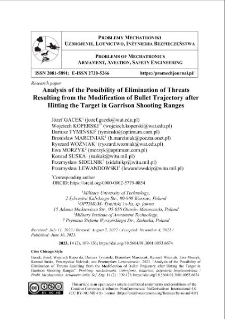Our Digital Library contains 1 868 digital objects
Object
Title: Analysis of the Possibility of Elimination of Threats Resulting from the Modification of Bullet Trajectory after Hitting the Target in Garrison Shooting Ranges
Alternative title:
Contributor:
Abstract:
During shooting operations in garrison shooting ranges, a phenomenon of random deflection of the bullet flight path was noticed which may cause secondary reflections from accidentally hit technical and ballistic shooting range elements and the ground of the actual plane of the shooting range (ricochets posing a threat to people and property within the shooting range and safety zones). Minimisation of this phenomenon must be considered during the design and operation of the shooting ranges. In 2020-2022 the Military Institute of Armament Technology (Zielonka, Poland) carried out tests with the aim of determining the impact of the shooting target or military target material or design (hereinafter referred to as the targets) on the risk of occurrence of modifications of bullet trajectory that cause the bullets to leave the shooting zone. The paper presents example results of these tests that show, but are not limited to, that the reasons to modify the direction of the bullet path after target penetration and any ricochets include: target material (flat or corrugated sheet metal, cardboard, plywood, etc.), target wooden legs, and even metal elements fixing the legs to the target. On the basis of the test it was shown that the metal targets prohibited on intermediate lines may cause significant deflections of the bullet flight path after penetration and dangerous ricochets. Due to the reason presented above, the metal targets are placed on the last line of targets before the main bullet trap only where the technical and ballistic parameters of the bullet trap ensure that any ricochets are captured. It was stated that the contact targets used on intermediate target lines and provided with wooden legs may cause bullet trajectory changes comparable to or even greater than in the case of the prohibited metal targets. To this end it is advisable to establish legal framework covering the ballistic inspection of the target materials to be used in garrison shooting ranges.
Place of publishing:
Warszawa
Publisher:
Date created:
Date submitted:
Date accepted:
Date issued:
Extent:
Identifier:
oai:ribes-88.man.poznan.pl:2676
Call number:
Electronic ISSN:
Print ISSN:
Language:
License:
Rights holder:
Starting page:
Ending page:
Volume:
Journal:
Keywords:
ballistics, shooting range, ricochet
Object collections:
Last modified:
Oct 15, 2025
In our library since:
Oct 15, 2025
Number of object content hits:
0
All available object's versions:
https://ribes-88.man.poznan.pl/publication/3009
Show description in RDF format:
Show description in OAI-PMH format:
Objects Similar
Józef GACEK Paweł MAZUR
Józef GACEK Małgorzata PAC
Józef GACEK Krzysztof MOTYL, Konrad SIENICKI ,Bronisław WAJSZCZYK
Józef GACEK Bronisław MARCINIAK, Ryszard WOŹNIAK

